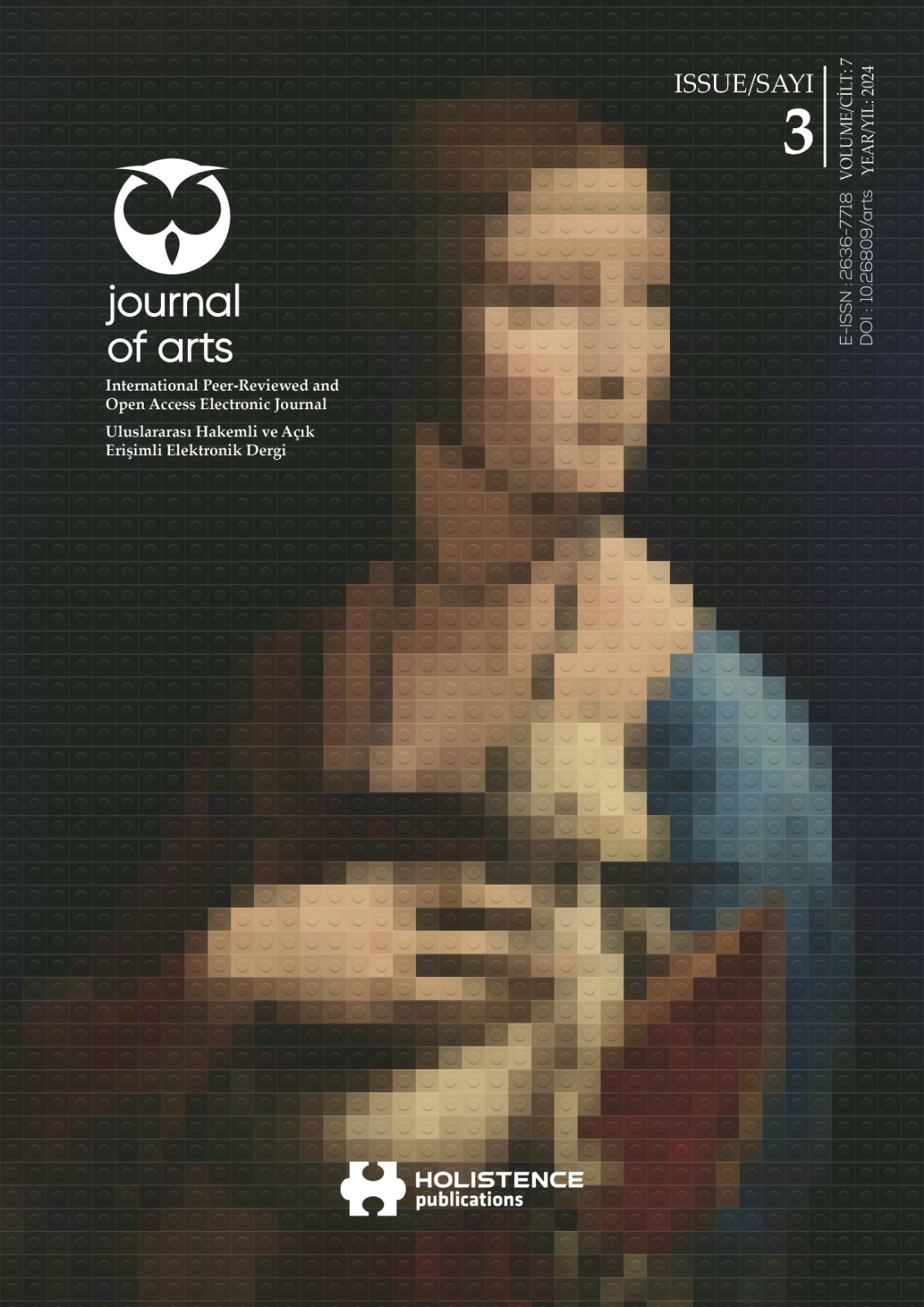Examining Akira Kurosawa’s use of color as a director and painter: an example of the movie “Ran”
DOI:
https://doi.org/10.31566/arts.2461Keywords:
Color, Visual Storytelling, Kurosawa Cinema, Color in CinemaAbstract
Cinema is a complex structure formed by the combination of many visual and sonic elements. When considered together with factors such as scenes, plans changing with the movement of the camera, visual compositions and editing, the strategic importance of each unit that creates meaning comes to the fore. Among these elements, color appears as an important element that is effective both in the context of visual aesthetics and composition, as well as in the context of human psychology, emotions and identification.
Color has been the focus of directors and researchers since the early years of cinema, which started with black and white. Unlike the research conducted in this field, this article focuses on Akira Kurosawa, a director whose first relationship with color was established through the art of painting and who gained worldwide recognition with his original films, and his film Ran (1985). The research examines the effect of the director's painter identity on the use of color in the film and the functions and use of colors on visual composition, character representation and dramatic structure in cinematic productions.
In this context, Kurosawa's approach to color in the paintings he made before shooting was determined, and a color-oriented visual and content analysis was carried out by following the plot that forms the narrative in the movie Ran. As a result of this analysis, it was seen that Kurosawa used the color element consciously, versatilely and functionally in his movie "Ran". Color palettes in warm-vibrant or cold-dark tones used throughout the film are used to convey the atmosphere and dramatic structure of the scenes to the audience in a more intense and profound way, to express the main characters, their characteristics and their ongoing journey throughout the film in the most effective way that the audience can identify with. It was concluded that he used it to ensure that the audience could easily follow the movie during crowded battle scenes. The findings provide important inferences about how colors can be an effective tool in film narrative and aim to offer new perspectives for studies in the field of cinema and color.
Downloads
References
AKKOYUNLU ERSÖZ, B., ÇOLAKOĞLU , F. & BAHAR, T.M. DÜZ. (2009). Kurosawa: Desenler. İstanbul: Pera Müzesi.
BELLANTONİ, P. (2005). If It’s Purple, Someone’s Gonna Die: Power of Color in Visual Storytelling. Oxford: Focal Press.
BOZ, Ö. (2021). Sinema ve Resim Ekseninde Medyalararası Bir İnceleme: Aşçı, Hırsız, Karısı ve Aşığı Filmi. Akdeniz Üniversitesi İletişim Fakültesi Dergisi, Issue 35, pp. 262-283.
BRANIGAN, E. (2018). Tracking Color in Cinema and Art: Philosophy and Aesthetics. New York: Routledge.
BÜKER, S. (2010). Sinemada Anlam Yaratma. İstanbul: Hayalbaz Kitap.
CHANT, I. (2021). The Brush And The Lens: Akira Kurosawa As Painter And Film Maker. [Çevrimiçi] Available at: https://www.popmatters.com/akira-kurosawa- painter-filmmaker [Erişildi: 01 05 2024].
ELLİOT, A. J. & MAİER, M. A. (2007). Color and Psychological Functioning. Current Directions in Psychological Science, 16(5), pp. 250-254.
ELLİOT, A. J. et al. (2007). Color and psychological functioning: The effect of red on performance attainment. Journal of Experimental Psychology: General, 136(1), pp. 154-168.
ERASLAN, R. U. (2020). Temel Renk Armonilerinin; Sanat, Tasarım ve Sinema Alanların Da Kullanımı. Fine Arts, 15(1), pp. 71-87.
HİLL, R. A. & BARTON, R. A. (2005). Red enhances human performance in contests. Nature, Cilt 435, p.293.
HİRANO, K. & KUROSAWA, A. (1986). Making Films for All the People: An Interview With Akira Kurosawa. Cineaste, 14(4), pp. 23-25.
KIRIK, A. M. (2013). Sinemada Renk Öğesinin Kullanımı: Renk ve Anlatım İlişkisi. pp. 71-.
KOCA, Ş. E. (2019). Sinemada Anlam Yaratma Sürecinde Rengin Metaforik Kullanımı. Sanat ve Tasarım Dergisi, Cilt 23, pp. 223-239.
KUROSAWA, A. (2006). Kurbağa Yağı Satıcısı. İstanbul: Agora Kitaplığı.
MCDONALD, K. I. (2006). Reading a Japanese Film: Cinema in Context. Honolulu: University of Hawai Press.
MOCKENHAUPT,B. (2007). EsquireMagazine.[Online] Available at: https://www.esquire.com/news-politics/a2155/esq0307fincher/[Accessed 05 05 2024].
O’CONNOR, Z. (2011). Colour psychology and colour therapy: Caveat emptor. Color Research & Application, 36(3), pp. 229-234.
PESA, T. (2017). Sydney Film Festival | Akira Kurosawa: from canvas to screen. [Çevrimiçi] Available at: https://www.art-almanac.com.au/sydney-film-festival-akira-kurosawa-canvas-screen/ [Erişildi: 01 06 2024].
PRİNCE, S. (1991). The Warrior’s Camera: The Cinema of Akira Kurosawa- Revised and Expanded Edition. Basım yeri bilinmiyor: Princeton University Press.
RICHIE, D. (1985). The Films of Akira Kurosawa. Berkeley: University of California Press.
SERPER, Z. (2000). Blood Visibility/invisibility in Kurosawa’s Ran. Literature/Film Quartely, 28(2), pp.149-154.
SÖZEN, M. (2003). Sinemada Renk: Sembolik Anlamlar. Ankara: Detay Yayıncılık.
VACCHE, A. D. & PRİNCE, B. (2006). Color the Film Reader. New York: Routledge.
WATKİNS, L. (2002). Light, Colour and Sound in Cinema. Paragraph, 25(3), pp. 117-128.
YÜKSEL, A. (2009). Exterior Color and Perceived Retail Crowding: Effects on Tourists’ Shopping Quality Inferences and Approach Behaviors. Journal of Quality Assurance in Hospitality & Tourism, 10(4), pp. 233-254.
ULUDAĞ ERASLAN, R. (2020). Temel Renk Armonilerinin; Sanat, Tasarım ve Sinema Alanların Da Kullanımı. Fine Arts, 15(1), 71-87.
Additional Files
Published
How to Cite
Issue
Section
License
Copyright (c) 2024 Holistence Publications

This work is licensed under a Creative Commons Attribution 4.0 International License.
When the article is accepted for publication in the Journal of Arts, authors transfer all copyright in the article to the Rating Academy Ar-Ge Yazılım Yayıncılık Eğitim Danışmanlık ve Organizasyon Ticaret Ltd. Şti.The authors reserve all proprietary right other than copyright, such as patent rights.
Everyone who is listed as an author in this article should have made a substantial, direct, intellectual contribution to the work and should take public responsibility for it.
This paper contains works that have not previously published or not under consideration for publication in other journals.










